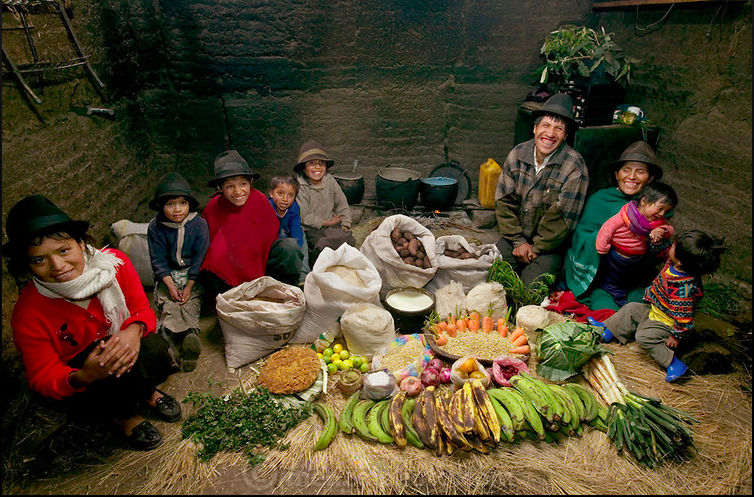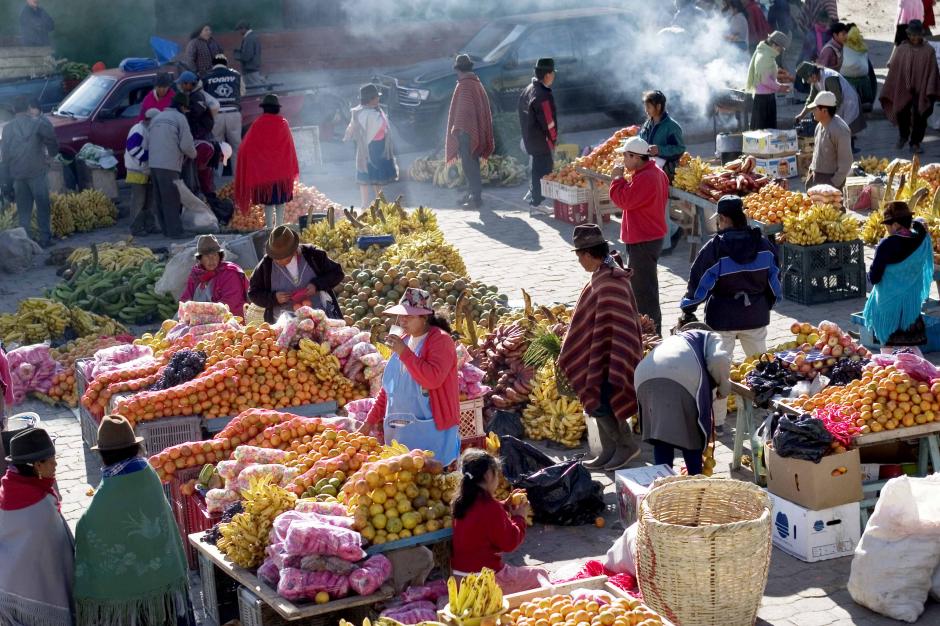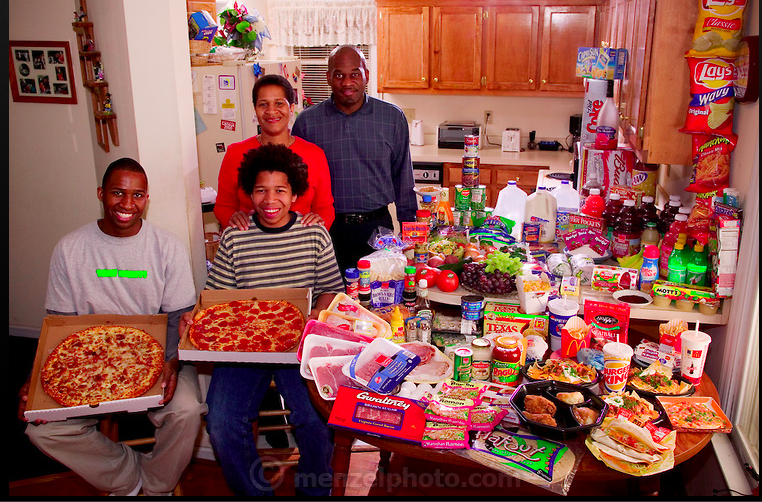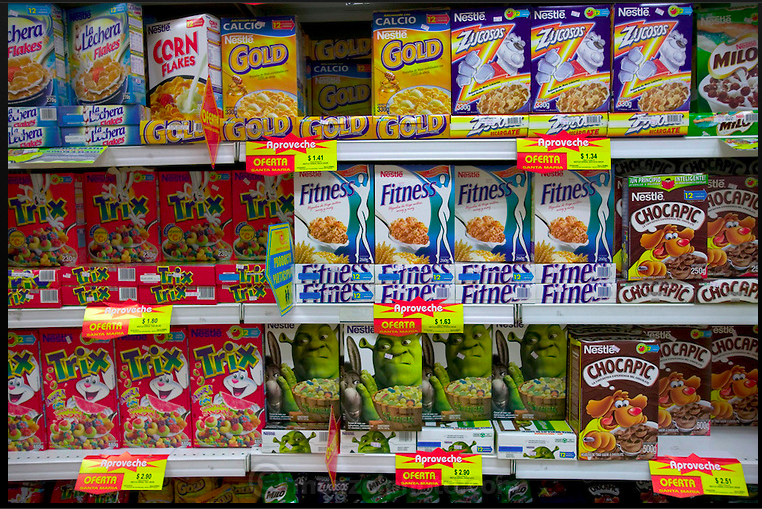The photos of what an American family and what an Ecuadorian family eat depicted in the photographic project Hungry Planet show sharp contrasts in the lifestyles and the food systems of those countries. Firstly, the Ecuadorian family lives in a traditional, rural village in the mountains in a thatch-roofed adobe-brick-walled hut. They don’t appear to have electricity, and their method of transportation to the nearest town is by walking. It’s hard to tell exactly from the photo of their family’s food for the week, but it seems like while they don’t have a ton of food that it could still be enough for them. Their food mostly consists of grains, potatoes, vegetables, and plantains. The family themselves have a potato farm.

Photo Credit: http://menzelphoto.photoshelter.com/gallery-image/Hungry-Planet-Ecuador/G0000xPkxxzKZB.c/I0000HW1fO6jwmIM/C00005yhI.83NTuU
A later image depicts the father, Orlando Ayme, selling two of his sheep for $35 at the town market in order to purchase potatoes, grains, and vegetables for his family.

http://egonzaecuador.weebly.com/uploads/1/4/9/4/14945276/7935566_orig.jpg
While we don’t know exactly what the family’s income is, we could assume that, due to their lack of electricity and transportation, they probably spend a larger percentage of their income on food than do their American counterparts. This is in line with Rosenberg’s analysis of the Middle East, in that “the lowest income groups spend a large part of their income on food, making them vulnerable to relatively small increases in its price.” In the U.S., to contrast, the percentage is a mere 9.8% (Carolan 2). Yet, Pollan sees this statistic as an indicator of the U.S.’s poor health outcomes; he states, “traditionally people have allocated a far greater proportion of their income to food-as they still do in several of the countries where people eat better than we do and as a consequence are healthier than we are” (145). In general, Pollan advocates for “traditional” diets as can be seen by the Ecuadorian family. Such diets can be vastly diverse but share the common denominator of not containing processed foods (Pollan 161). Thus, while the Ecuadorian family does not have a huge amount of weekly food, what they have is “real” food.
On the flip side in North America, the three American families depicted have vast quantities of food, but not what Pollan would refer to as “real food.”

Photo credit: http://menzelphoto.photoshelter.com/gallery-image/Hungry-Planet-USA/G0000TOYLkK__2Ho/I0000MKg0bMaCq6Y/C00005yhI.83NTuU
Rather, one can see lots of packaged foot, soft drinks, fast food, and little fruits and vegetables. Although the family seems to be financially more well-off than the Ecuadorian one and have more food than them, they perhaps spend less of a percentage of their income on food than the Ecuadorian family does. This is due to a variety of policies that make processed food cheaper than fresh produce. As Carolan contends, “There are a lot of subsidies for the two things we should be limiting in our diet, which are sugar and fat, and there are not a lot of subsidies for broccoli and Brussels sprouts” (72). Yet, the family actually demonstrates concern for their health, as there are images of them going to the gym together. It was counterproductive, however, as they found the workouts “so time-consuming that they wound up eating more fast food than ever” (Menzel). This can be mirrored by Pollan’s contention that Americans contradictorily worry about health yet are unhealthy; “Indeed, no people on earth worry more about the health consequences of their food choices than we Americans do- and no people suffer from as many diet-related health problems” (8).
Though in opposite ends of the Americas, one can actually see the link between the United States and Ecuador in the following photo of a Quito supermarket:

Photo credit: http://menzelphoto.photoshelter.com/gallery-image/Hungry-Planet-Ecuador/G0000xPkxxzKZB.c/I0000Ja5HFjP4Ij0/C00005yhI.83NTuU
As previously touched upon, consumption of processed foods is encouraged by the huge subsidies the U.S. government provides for growing corn, wheat, and soy. This not only makes the packaged food as seen in the American family’s weekly groceries more affordable, but it also leads to great surpluses of food. These surpluses end up being “dumped” on the global market. Shiva explains how this process in turn “brings down prices worldwide and destroys the livelihoods of millions of peasants.” While the outdoor market shown in the earlier photo demonstrates the traditional way of life for many Ecuadorians, the above photo of the supermarket shelves show how globalization is facilitating a change in the way of life in the bigger cities. Although Shiva contends that subsidized American food products are cheaper than local goods in foreign markets, Menzel states that, in Ecuador, “although prices are higher, some who can afford them prefer to shop in the supermarkets because foreign brands, local produce and meat products can be found in one location, under one roof.” However, as supermarkets grow in popularity in Ecuador, the outdoor markets- and the livelihood of the Ecuadorian family depicted in the photos- could be threatened.
Works Cited:
Carolan, Michael. The Real Cost of Cheap Food. Earthscan, 2011.
Menzel, Peter. Hungry Planet: North and South America. Peter Menzel Photography. menzelphoto.photoshelter.com/gallery-collection/Hungry-Planet-North-South-America/C00005yhI.83NTuU. Accessed 25 July 2017.
Pollan, Michael. In Defense of Food: An Eater’s Manifesto. Penguin Books, 2008.
Rosenberg, David. “FOOD AND THE ARAB SPRING.” MERIA: Middle East Review of International Affairs, vol. 15, no. 3, 2011, pp. MERIA: Middle East Review of International Affairs, September 2011, Vol.15(3).
Shiva, Vandana. “The Real Reasons for Hunger.” The Guardian, 23 June 2012. Global Policy Forum, www.globalpolicy.org/component/content/article/162/27748.html. Accessed 28 July 2017.
